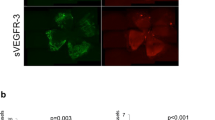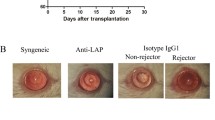Abstract
• Background: Activation of T cells requires both the interaction of T-cell receptor with major histocompatibility complex on the antigen-presenting cell and costimulatory signals, for instance the B7 antigens expressed on antigen-presenting cells and the CD28 molecule expressed on T cells. A recombinant fusion protein, CTLA4-Ig, has been produced that contains the extracellular domain of human CTLA4 fused to IgGl constant region and that binds the B7 molecule with high affinity. Blocking the CD28/B7 interaction with CTLA4-Ig inhibits T cell activation in vitro and in vivo. • Methods: We used CTLA4-Ig in a fully MHC-mismatched mouse keratoplasty model. The animals were divided into four groups: (1) no treatment, (2) intraperitoneal treatment with 130 μg CTLA4-Ig, (3) intraperitoneal treatment with 300 μg CTLA4-Ig, (4) subconjunctival treatment with 290 μg CTLA4-Ig. • Results: The allograft reaction occurred in untreated animals between days 12 and 16 (mean 13.5). While topical application of CTLA4-Ig seemed to shorten the graft survival (mean 11.6 days) and systemic application of 130 μg had no influence (mean 14.0), only intraperitoneal injection of 300 μg of CTLA4-Ig prolonged the survival of allografts (mean >20 days) (P<0.01). • Conclusion: CTLA4-Ig prolonged significantly the survival of corneal allografts in a fully MHC-mismatched mouse keratoplasty model, but the small antigen load of the corneal transplant and the anterior chamber-associated immune deviation (ACAID) may have a disadvantage to induce tolerance in this model of CTLA4-Ig therapy.
Similar content being viewed by others
References
Baliga P, Chavin KD, Qin L, Woodward J, Lin J, Linsley PS, Bromberg JS (1994) CTLA4Ig prolongs allograft survival while suppressing cell-mediated immunity. Transplantation 58: 1082–1090
Blazar BR, Taylor PA, Linsley PS, Vallera DA (1994) In vivo blockade of CD28/CTLA4: B7/BB1 interaction with CTLA4-Ig reduces lethal murine graft-versus-host disease across the major histocompatibility complex barrier in mice. Blood 83: 3815–3825
Bolling SF, Lin H, Wei RQ, Linsley P, Turka LA (1994) The effect of combination cyclosporine and CTLA4-Ig therapy on cardiac allograft survival. J Surg Res 57:60–64
Chahine AA, Yu M, McKernan M, Stoeckert C, Linsley PS, Lau HT (1994) Local CTLA4Ig synergizes with one-dose anti-LEA-1 to achieve long-term acceptance of pancreatic islet allografts. Transplant Proc 26: 3296
Freeman GJ, Borriello F, Hodes RJ, Reiser H, Gribben JG, Ng JW Kim J, Goldberg JM, Hathcock K, Laszlo G, et al. (1993) Murine B7-2, an alternative CTLA4 counter-receptor that costimulates T cell proliferation and interleukin 2 production. J Exp Med 178:2185–2192
Griffith TS, Brunner T, Fletcher SM, Green DR, Ferguson TA (1995) Fasligand induced apoptosis as a mechanism of immune privilege. Science 270:1189–1192
Hakim FT, Cepeda R, Gray GS, June CH, Abe R (1995) Acute graft-versushost reaction can be aborted by blockade of costimulatory molecules. J Immunol 155: 1757–1766
Joo C-K, Pepose JS, Stuart PM (1995) T-cell mediated responses in a routine model of orthotopic corneal transplantation. Invest Ophthalmol Vis Sci 36:1530–1540
Kunzendorf U, Pohl T, Bulfone PS, Krause H, Notter M, Onu A, Walz G, Diamantstein T (1996) Suppression of cell-mediated and Immoral immune responses by an interleukin-2-immunoglobulin fusion protein in mice. J Clin Invest 97: 1204–1210
Lane P, Gerhard W, Hubele S, Lanzavecchia A, McConnell F (1993) Expression and functional properties of mouse B7/BB1 using a fusion protein between mouse CTLA4 and human g1. Immunology 80:56–61
Lane P, Haller C, McConnell F (1996) Evidence that induction of tolerance in vivo involves active signaling via a B7 ligand-dependent mechanism: CTLA4-Ig protects V beta 8+ T cells from tolerance induction by the superantigen staphylococcal enterotoxin B. Eur J Immunol 26:858–862
Lin H, Bolling SF, Linsley PS, Wei RQ, Gordon D, Thompson CB, Turka LA (1993) Long-term acceptance of major histocompatibility complex mismatched cardiac allografts induced by CTLA4Ig plus donor — specific transfusion. J Exp Med 178: 1801–1806
Linsley PS, Wallace PM, Johnson J, Gibson MG, Greene JL, Ledbetter JA, Singh C, Tepper MA (1992) Immunosuppression in vivo by a soluble form of the CTLA-4 T cell activation molecule. Science 257:792–795
Matsumura Y, Zuo XJ, Prehn J, Linsley PS, Marchevsky A, Kass RM, Matloff JM, Jordan SC (1995) Soluble CTLA4Ig modifies parameters of acute inflammation in rat lung allograft rejection without altering lymphocytic infiltration or transcription of key cytokines. Transplantation 59:551–558
Niederkorn JY, Mayhew E (1993) “Subthreshold stimulation” of allospecific delayed hypersensitivity by corneal allografts. Immunology 80:605–610
Niederkorn JY, Streilein JW, Shadduck JA (1980) Deviant immune responses to allogeneic tumors injected intracamerally and subcutaniously in mice. Invest Ophthalmol Vis Sci 20: 355–363
Pearson TC, Alexander DZ, Winn KJ, Linsley PS, Lowry RP, Larsen CP (1994) Transplantation tolerance induced by CTLA4-Ig. Transplantation 57:1701–1706
Pearson TC, Alexander DZ, Hendrix R, Elwood ET, Linsley PS, Winn KJ, Larsen CP (1996) CTLA4-Ig plus bone marrow induces long-term allograft survival and donor specific unresponsiveness in the murine model. Evidence for hematopoietic chimerism. Transplantation 61: 997–1004
Ray-Keil L, Chandler JW (1985) Rejection of murine heterotopic corneal transplants. Transplantation 39:473–477
Russell ME, Hancock WW, Akalin E, Wallace AF, Glysing JT, Willett TA, Sayegh MH (1996) Chronic cardiac rejection in the LEW to F344 rat model. Blockade of CD28-B7 costimulation by CTLA4Ig modulates T cell and macrophage activation and attenuates arteriosclerosis. J Clin Invest 97:833–838
Sano Y, Ksander BR, Streilein JW (1995) Fate of orthotopic corneal allografts in eyes that cannot support anterior chamber-associated immune deviation induction. Invest Ophthalmol Vis Sci 36:2176–2185
Sayegh MH, Akalin E, Hancock WW Russell ME, Carpenter CB, Linsley PS, Turka LA (1995) CD28-B7 blockade after alloantigenic challenge in vivo inhibits Thl cytokines but spares Th2. J Exp Med 181:1869–1874
She S-C, Steahly LP, Moticka EJ (1990) A method for performing fullthickness, orthotopic, penetrating keratoplasty in the mouse. Ophthalmic Surg 21:781–785
She SC, Steahly LP, Moticka EJ (1990) Intracameral injection of allogeneic lymphocytes enhances corneal graft survival. Invest Ophthalmol Vis Sci 31: 1950
Sonoda Y, Streilein JW (1992) Orthotopic corneal transplantation in mice — evidance that the immunogenic rules of rejection do not apply. Transplantation 54:694–704
Sonoda Y, Streilein JW (1993) Impaired cell-mediated immunity in mice bearing healthy orthotopic corneal allografts. J Immunol 150: 1727–1734
Streilein JW, Toews GB, Bergstresser PR (1979) Corneal allografts fail to express la antigens. Nature 282: 326–327
Streilein JW, McCulley J, Niederkorn JY (1982) Heterotopic corneal grafting in mice. A new approach to the study of corneal alloimmunity. Invest Ophthalmol Vis Sci 23:489–500
Streilein JW, Wilbanks GA, Cousins SW (1992) Immunoregulatory mechanisms of the eye. J Neuroimmunol 39: 185–200
Tan P, Anasetti C, Hansen JA, Melrose J, Brunvand M, Bradshaw J, Ledbetter JA, Linsley PS (1993) Induction of alloantigen-specific hyporesponsiveness in human T lymphocytes by blocking interaction of CD28 with its natural ligand B7/BB1. J Exp Med 177:165–173
Wallace PM, Johnson JS, MacMaster JF, Kennedy KA, Gladstone P, Linsley PS (1994) CTLA4Ig treatment ameliorates the lethality of murine graftversus-host disease across major histocompatibility complex barriers. Transplantation 58:602–610
Weber CJ, Hagler MK, Chryssochoos JT, Larsen CP, Pearson TC, Jensen P, Kapp JA, Linsley PS (1996) CTLA4Ig prolongs survival of microencapsulated rabbit islet xenografts in spontaneously diabetic Nod mice. Transplant Proc 28:821–823
Wilson SE, Li Q, Weng J, Barry-Lane PA, Jester JV, Liang Q, Wordinger RJ (1996) The Fas-Fas ligand system and other modulators of apoptosis in the cornea. Invest Ophthalmol Vis Sci 37:1582–1592
Wu Y, Guo Y, Liu Y (1993) A major costimulatory molecule on antigen-presenting cells, CTLA4 ligand A, is distinct from B7. J Exp Med 178: 789–1793
Yao YF, Inoue Y, Miyazaki D, Shimomura Y, Ohashi Y, Tano Y (1995) Ocular resurfing and alloepithelial rejection in a murine keratoepitheliopathy model. Invest Ophthalmol Vis Sci 36: 2623–2633
Yin D, Fathman CG (1995) Induction of tolerance to heart allografts in high responder rats by combining anti-CD4 with CTLA4Ig. J Immunol 155:1655–1659
Young E, Stark WJ, Prendergast RA (1985) Immunology of corneal allograft rejection: HLA-DR antigens on human corneal cells. Invest Ophthalmol Vis Sci 26:571–574
Zhang EP, Schründer S, Hoffmann F (1996) Orthotopic corneal transplantation in the mouse — a new surgical technique with minimal endothelial cell loss. Graefe's Arch Clin Exp Ophthalmol 234: 714–719
Author information
Authors and Affiliations
Corresponding author
Rights and permissions
About this article
Cite this article
Hoffmann, F., Zhang, EP., Pohl, T. et al. Inhibition of corneal allograft reaction by CTLA4-Ig. Graefe's Arch Clin Exp Ophthalmol 235, 535–540 (1997). https://doi.org/10.1007/BF00947013
Received:
Revised:
Accepted:
Issue Date:
DOI: https://doi.org/10.1007/BF00947013




